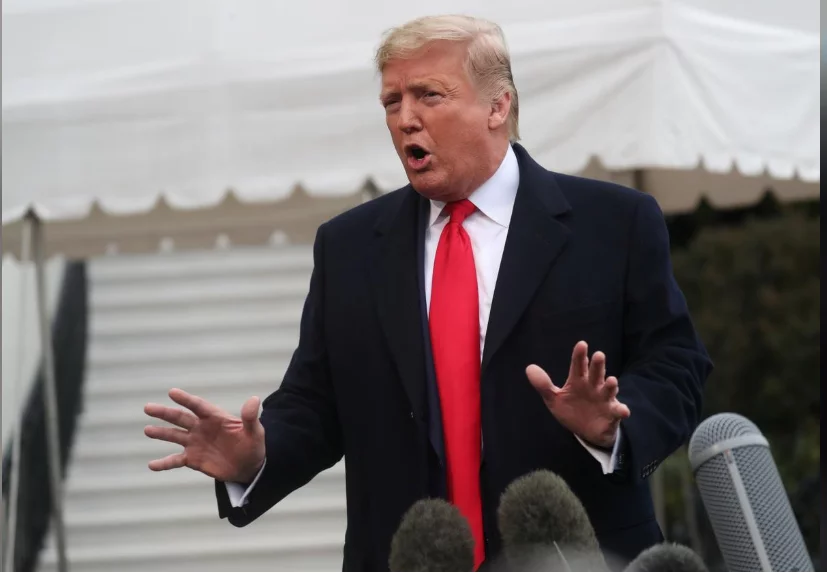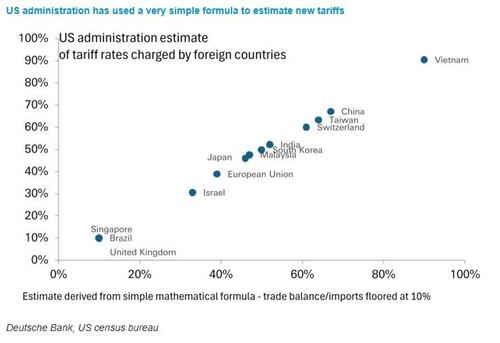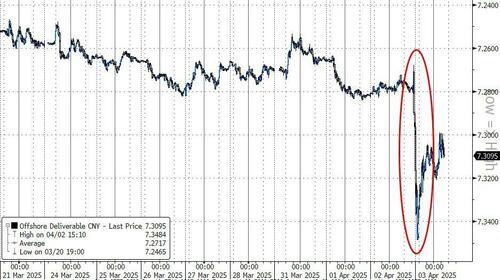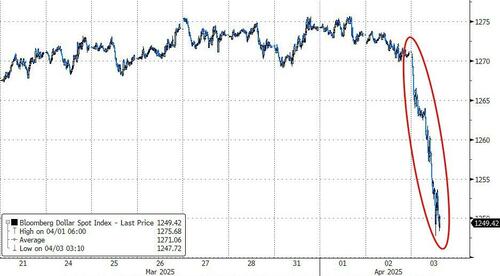Uddrag fra Deutsche Bank:
‘
Heading into Trump’s announcement last night, George Saravelos, Global Head of FX Research at Deutsche Bank, warned the broader the tariffs, the more negative the effect is likely to be on the US (less scope for re-direction of trade and greater inflation pass-through) and by extension US risk assets, recession probabilities and ultimately the USD.
The outcome – judging from the panicked reaction across markets overnight – was worse than expected: higher and broader tariff levels taking almost immediate effect.
However, as Saravelos writes this morning, the details matter when considering FX moves.
Quick summary of President Trump’s announcements:
- tariffs on the American continent are lower than expected,
- European tariffs are as expected,
- tariffs on Asia significantly higher than expected.
There should be a straightforward FX re-adjustment between Asia FX (weak) and Latam FX + CAD (strong) in coming days.
In his announcements overnight President Trump presented a list of estimated tariff rates that foreign countries are applying on US goods, also “including currency manipulation and other trade barriers.” These were subsequently used as the basis for which reciprocal US tariffs were calculated. There has been subsequent reporting that the method of calculating these tariff rates was reliant on a rather more simple approach. We can indeed confirm that using US census bureau trade data for 2024, the ratio of a country’s goods trade deficit with the US over that country’s exports to the US yields the same results.
Put simply, the bigger the nominal trade deficit a country has with the US adjusted for the absolute size of that country’s imports, the bigger the tariff.
We draw three conclusions from this analysis:
- First, the US administration is squarely focused on penalizing countries with larger trade deficits in goods (services are ignored). This determination is highly mechanical, rather than a sophisticated assessment of tariff and non-tariff barriers. It is also in line with the declaration of a national emergency on the trade deficit used as a legal justification for the tariffs.
- Second, there is a very large disconnect between communication in recent weeks of an in-depth policy assessment of bilateral trade relationships with different countries versus the reality of the policy outcome. We worry this risks lowering the policy credibility of the administration on a forward-looking basis. The market may question the extent to which a sufficiently structured planning process for major economic decisions is taking place. After all, this is the biggest trade policy shift from the US in a century. Crucially, major additional fiscal decisions are lining up over the next two months.
- Third, the tariff calculation approach arguably makes for a more free-wheeling and open-ended nature to potential trade negotiations in coming months. It seems there are no specific and identifiable policy asks per se but ultimately a desire to reduce bilateral trade imbalances.
Bigger picture, the big determinant of the market moves over the next few weeks will be the relative fiscal policy stance in the US, Europe and China, not the tariffs themselves. We found Treasury Secretary Bessent’s emphasis on fiscal tightening right after the tariff announcement as un-supportive of both US assets and the dollar. In the meantime, there is already reporting that the European Commission is preparing economic support measures and the outcome of the German coalition talks will be important.
But beyond that, the key focus over the next few days should clearly be China.
There is no doubt that the big negative surprise today has been the 50%+ tariff rate on China and the key connector economy Vietnam – affecting $600bn worth of manufactured goods to the US combined.
The question is simple: how willing will China be to wait for trade negotiations (the 20% “fentanyl” tariff arguably leaves an opening) and/or to absorb this negative terms of trade shock domestically via fresh domestic demand stimulus?
Or will it try to “export” the shock to the rest of the world via a devaluation of the CNY to regain goods competitiveness and re-direct the supply of Chinese product to the rest of the world? We have been writing about the implications of a Chinese “tariff wall” for a while. The scenario of CNY devaluation is more deflationary and dollar positive for the rest of the world. The stimulus scenario much more positive.
At risk of oversimplifying, given that China and its connector economies are taking the brunt of the Trump tariff shock, the negative global spillover to the rest of the world in coming days will largely be determined by the extent to which China allows the policy-determined USD/CNY to move materially above 7.20 or decides to do more fiscal stimulus instead.
All eyes on USD/CNH and the CNY fixings. We will soon find out.
The dollar has experienced a sharp decline since President Trump announced the new US administration’s tariff policy a few hours ago. We have written about why the stability in USD/CNY, the problematic policy communication around the tariffs and the anticipation of more fiscal support measures from the rest of the world are all contributing to a weaker dollar. But given the dramatic nature of the moves, we are becoming increasingly concerned that the dollar is at risk of a broader confidence crisis.
We have been warning about the importance of the correlation breakdown between US risk assets and the dollar for a while – European losses on US assets are now exceeding those seen during the 2022-2023 crisis. The safe haven properties of the dollar are being eroded and this is imposing a significant cost on unhedged dollar holdings. Beyond that, developments since the start of the year make us worried about a broader undermining of confidence in the US economic outlook and the medium-term desirability of dollar allocations.
All of this risks a self-fulfilling unwind of extreme US asset overweights from countries that have exported capital to the US over the last decade. Most of the developed world belongs to this category. At the end of the day, the US has a large current account deficit, and the currency is reliant on capital inflows for stability. A drop in the dollar, a drop in US equities and a rise in term premium in US treasuries would be the strongest market signal that a process of US disinvestment is accelerating. A rise in term premia on US treasuries has not materialized yet, but it would be a very negative signal if it did.
Our overall message is that there is a risk that major shifts in capital flow allocations take over from currency fundamentals and that FX moves become disorderly. We would caution that if the dollar decline accelerates, it would be a highly unwelcome development for global central banks. The last thing the ECB wants is an externally imposed disinflationary shock from a loss in dollar confidence and a sharp appreciation in the euro on top of tariffs.
Expect pushback. We are in the midst of dramatic regime change in markets.
Intro-pris i 3 måneder
Få unik indsigt i de vigtigste erhvervsbegivenheder og dybdegående analyser, så du som investor, rådgiver og topleder kan handle proaktivt og kapitalisere på ændringer.
- Fuld adgang til ugebrev.dk
- Nyhedsmails med daglige opdateringer
- Ingen binding
199 kr./måned
Normalpris 349 kr./måned
199 kr./md. de første tre måneder,
herefter 349 kr./md.
Allerede abonnent? Log ind her




